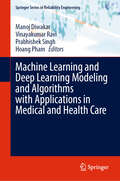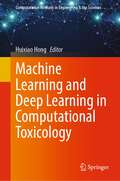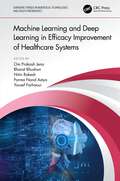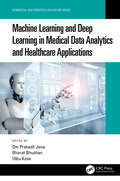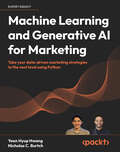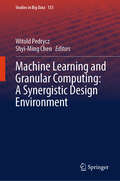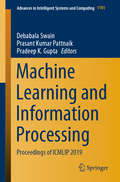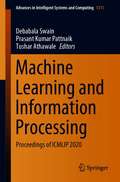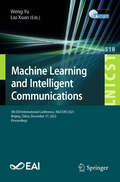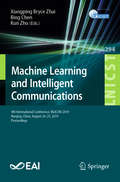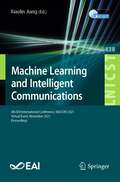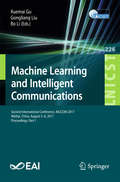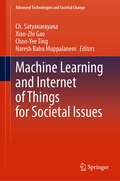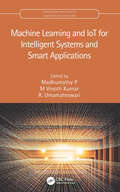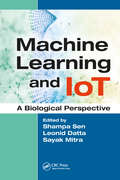- Table View
- List View
Machine Learning and Deep Learning Modeling and Algorithms with Applications in Medical and Health Care (Springer Series in Reliability Engineering)
by Hoang Pham Vinayakumar Ravi Prabhishek Singh Manoj DiwakarThis book explains medical image processing and analysis using deep learning algorithms to analyze medical data. It focuses on the latest achievements and developments in applying this analysis to medical imaging, clinical, and other healthcare applications. The book covers among other areas: Image acquisition and formation. Computer-aided diagnosis. Image classification. Feature extraction. Image enhancement/segmentation. Medical image processing issues such as segmentation, visualization, registration, and navigation may seem to be distinct, yet they are all intertwined in the process of resolving clinical bottlenecks. Using deep learning algorithms, researchers were able to achieve record-breaking performance and set the bar for future research. Due to the extensive quantity of medical imaging data of CT scan, ultrasound, and MRI, there is widespread use of machine learning, specifically deep learning, to discover specific patterns on such data. Such large data is well quantified by deep learning models. Deep learning is now being utilized, customized, and particularly developed for medical image analysis, as opposed to when it was first introduced to the community. Having learned more about the techniques, researchers have come up with innovative ideas for combining artificial intelligence (AI) with neural networks to solve difficult issues like medical image reconstruction. The key features of this book are: Machine learning and deep learning applications. Medical imaging applications. Feature extraction and analysis. Medical image classification, segmentation, recognition, and registration. Medical image analysis and enhancement. Handling medical image dataset.
Machine Learning and Deep Learning Techniques in Wireless and Mobile Networking Systems (Big Data for Industry 4.0)
by G. Rajesh K. Suganthi R. Karthik Peter Ho Chiung ChingThis book offers the latest advances and results in the fields of Machine Learning and Deep Learning for Wireless Communication and provides positive and critical discussions on the challenges and prospects. It provides a broad spectrum in understanding the improvements in Machine Learning and Deep Learning that are motivating by the specific constraints posed by wireless networking systems. The book offers an extensive overview on intelligent Wireless Communication systems and its underlying technologies, research challenges, solutions, and case studies. It provides information on intelligent wireless communication systems and its models, algorithms and applications. The book is written as a reference that offers the latest technologies and research results to various industry problems.
Machine Learning and Deep Learning in Computational Toxicology (Computational Methods in Engineering & the Sciences)
by Huixiao HongThis book is a collection of machine learning and deep learning algorithms, methods, architectures, and software tools that have been developed and widely applied in predictive toxicology. It compiles a set of recent applications using state-of-the-art machine learning and deep learning techniques in analysis of a variety of toxicological endpoint data. The contents illustrate those machine learning and deep learning algorithms, methods, and software tools and summarise the applications of machine learning and deep learning in predictive toxicology with informative text, figures, and tables that are contributed by the first tier of experts. One of the major features is the case studies of applications of machine learning and deep learning in toxicological research that serve as examples for readers to learn how to apply machine learning and deep learning techniques in predictive toxicology. This book is expected to provide a reference for practical applications of machine learning and deep learning in toxicological research. It is a useful guide for toxicologists, chemists, drug discovery and development researchers, regulatory scientists, government reviewers, and graduate students. The main benefit for the readers is understanding the widely used machine learning and deep learning techniques and gaining practical procedures for applying machine learning and deep learning in predictive toxicology.
Machine Learning and Deep Learning in Efficacy Improvement of Healthcare Systems (Emerging Trends in Biomedical Technologies and Health informatics)
by Om Prakash JenaThe goal of medical informatics is to improve life expectancy, disease diagnosis and quality of life. Medical devices have revolutionized healthcare and have led to the modern age of machine learning, deep learning and Internet of Medical Things (IoMT) with their proliferation, mobility and agility. This book exposes different dimensions of applications for computational intelligence and explains its use in solving various biomedical and healthcare problems in the real world. This book describes the fundamental concepts of machine learning and deep learning techniques in a healthcare system. The aim of this book is to describe how deep learning methods are used to ensure high-quality data processing, medical image and signal analysis and improved healthcare applications. This book also explores different dimensions of computational intelligence applications and illustrates its use in the solution of assorted real-world biomedical and healthcare problems. Furthermore, it provides the healthcare sector with innovative advances in theory, analytical approaches, numerical simulation, statistical analysis, modelling, advanced deployment, case studies, analytical results, computational structuring and significant progress in the field of machine learning and deep learning in healthcare applications. FEATURES Explores different dimensions of computational intelligence applications and illustrates its use in the solution of assorted real-world biomedical and healthcare problems Provides guidance in developing intelligence-based diagnostic systems, efficient models and cost-effective machines Provides the latest research findings, solutions to the concerning issues and relevant theoretical frameworks in the area of machine learning and deep learning for healthcare systems Describes experiences and findings relating to protocol design, prototyping, experimental evaluation, real testbeds and empirical characterization of security and privacy interoperability issues in healthcare applications Explores and illustrates the current and future impacts of pandemics and mitigates risk in healthcare with advanced analytics This book is intended for students, researchers, professionals and policy makers working in the fields of public health and in the healthcare sector. Scientists and IT specialists will also find this book beneficial for research exposure and new ideas in the field of machine learning and deep learning.
Machine Learning and Deep Learning in Medical Data Analytics and Healthcare Applications (Biomedical and Robotics Healthcare)
by Om Prakash JenaMachine Learning and Deep Learning in Medical Data Analytics and Healthcare Applications introduces and explores a variety of schemes designed to empower, enhance, and represent multi-institutional and multi-disciplinary machine learning (ML) and deep learning (DL) research in healthcare paradigms. Serving as a unique compendium of existing and emerging ML/DL paradigms for the healthcare sector, this book demonstrates the depth, breadth, complexity, and diversity of this multi-disciplinary area. It provides a comprehensive overview of ML/DL algorithms and explores the related use cases in enterprises such as computer-aided medical diagnostics, drug discovery and development, medical imaging, automation, robotic surgery, electronic smart records creation, outbreak prediction, medical image analysis, and radiation treatments. This book aims to endow different communities with the innovative advances in theory, analytical results, case studies, numerical simulation, modeling, and computational structuring in the field of ML/DL models for healthcare applications. It will reveal different dimensions of ML/DL applications and will illustrate their use in the solution of assorted real-world biomedical and healthcare problems. Features: Covers the fundamentals of ML and DL in the context of healthcare applications Discusses various data collection approaches from various sources and how to use them in ML/DL models Integrates several aspects of AI-based computational intelligence such as ML and DL from diversified perspectives which describe recent research trends and advanced topics in the field Explores the current and future impacts of pandemics and risk mitigation in healthcare with advanced analytics Emphasizes feature selection as an important step in any accurate model simulation where ML/DL methods are used to help train the system and extract the positive solution implicitly This book is a valuable source of information for researchers, scientists, healthcare professionals, programmers, and graduate-level students interested in understanding the applications of ML/DL in healthcare scenarios. Dr. Om Prakash Jena is an Assistant Professor in the Department of Computer Science, Ravenshaw University, Cuttack, Odisha, India. Dr. Bharat Bhushan is an Assistant Professor of Department of Computer Science and Engineering (CSE) at the School of Engineering and Technology, Sharda University, Greater Noida, India. Dr. Utku Kose is an Associate Professor in Suleyman Demirel University, Turkey.
Machine Learning and Deep Learning in Natural Language Processing
by Anitha S. Pillai Roberto TedescoNatural Language Processing (NLP) is a sub-field of Artificial Intelligence, linguistics, and computer science and is concerned with the generation, recognition, and understanding of human languages, both written and spoken. NLP systems examine the grammatical structure of sentences as well as the specific meanings of words, and then they utilize algorithms to extract meaning and produce results. Machine Learning and Deep Learning in Natural Language Processing aims at providing a review of current Neural Network techniques in the NLP field, in particular about Conversational Agents (chatbots), Text-to-Speech, management of non-literal content – like emotions, but also satirical expressions – and applications in the healthcare field. NLP has the potential to be a disruptive technology in various healthcare fields, but so far little attention has been devoted to that goal. This book aims at providing some examples of NLP techniques that can, for example, restore speech, detect Parkinson’s disease, or help psychotherapists. This book is intended for a wide audience. Beginners will find useful chapters providing a general introduction to NLP techniques, while experienced professionals will appreciate the chapters about advanced management of emotion, empathy, and non-literal content.
Machine Learning and Deep Learning in Neuroimaging Data Analysis
by Anitha S. Pillai Bindu MenonMachine learning (ML) and deep learning (DL) have become essential tools in healthcare. They are capable of processing enormous amounts of data to find patterns and are also adopted into methods that manage and make sense of healthcare data, either electronic healthcare records or medical imagery. This book explores how ML/DL can assist neurologists in identifying, classifying or predicting neurological problems that require neuroimaging. With the ability to model high-dimensional datasets, supervised learning algorithms can help in relating brain images to behavioral or clinical observations and unsupervised learning can uncover hidden structures/patterns in images. Bringing together artificial intelligence (AI) experts as well as medical practitioners, these chapters cover the majority of neuro problems that use neuroimaging for diagnosis, along with case studies and directions for future research.
Machine Learning and Generative AI for Marketing: Take your data-driven marketing strategies to the next level using Python
by Yoon Hyup Hwang Nicholas C. BurtchStart transforming your data-driven marketing strategies and increasing customer engagement. Learn how to create compelling marketing content using advanced gen AI techniques and stay in touch with the future AI ML landscape. Purchase of the print or Kindle book includes a free eBook in PDF formatKey FeaturesEnhance customer engagement and personalization through predictive analytics and advanced segmentation techniquesCombine Python programming with the latest advancements in generative AI to create marketing content and address real-world marketing challengesUnderstand cutting-edge AI concepts and their responsible use in marketingBook DescriptionIn the dynamic world of marketing, the integration of artificial intelligence (AI) and machine learning (ML) is no longer just an advantage—it's a necessity. Moreover, the rise of generative AI (GenAI) helps with the creation of highly personalized, engaging content that resonates with the target audience. This book provides a comprehensive toolkit for harnessing the power of GenAI to craft marketing strategies that not only predict customer behaviors but also captivate and convert, leading to improved cost per acquisition, boosted conversion rates, and increased net sales. Starting with the basics of Python for data analysis and progressing to sophisticated ML and GenAI models, this book is your comprehensive guide to understanding and applying AI to enhance marketing strategies. Through engaging content & hands-on examples, you'll learn how to harness the capabilities of AI to unlock deep insights into customer behaviors, craft personalized marketing messages, and drive significant business growth. Additionally, you'll explore the ethical implications of AI, ensuring that your marketing strategies are not only effective but also responsible and compliant with current standards By the conclusion of this book, you'll be equipped to design, launch, and manage marketing campaigns that are not only successful but also cutting-edge.What you will learnMaster key marketing KPIs with advanced computational techniquesUse explanatory data analysis to drive marketing decisionsLeverage ML models to predict customer behaviors, engagement levels, and customer lifetime valueEnhance customer segmentation with ML and develop highly personalized marketing campaignsDesign and execute effective A/B tests to optimize your marketing decisionsApply natural language processing (NLP) to analyze customer feedback and sentimentsIntegrate ethical AI practices to maintain privacy in data-driven marketing strategiesWho this book is forThis book targets a diverse group of professionals: Data scientists and analysts in the marketing domain looking to apply advanced AI ML techniques to solve real-world marketing challenges Machine learning engineers and software developers aiming to build or integrate AI-driven tools and applications for marketing purposes Marketing professionals, business leaders, and entrepreneurs who must understand the impact of AI on marketing Reader are presumed to have a foundational proficiency in Python and a basic to intermediate grasp of ML principles and data science methodologies
Machine Learning and Granular Computing: A Synergistic Design Environment (Studies in Big Data #155)
by Witold Pedrycz Shyi-Ming ChenThis volume provides the reader with a comprehensive and up-to-date treatise positioned at the junction of the areas of Machine Learning (ML) and Granular Computing (GrC). ML offers a wealth of architectures and learning methods. Granular Computing addresses useful aspects of abstraction and knowledge representation that are of importance in the advanced design of ML architectures. In unison, ML and GrC support advances of the fundamental learning paradigm. As built upon synergy, this unified environment focuses on a spectrum of methodological and algorithmic issues, discusses implementations and elaborates on applications. The chapters bring forward recent developments showing ways of designing synergistic and coherently structured ML-GrC environment. The book will be of interest to a broad audience including researchers and practitioners active in the area of ML or GrC and interested in following its timely trends and new pursuits.
Machine Learning and Information Processing: Proceedings of ICMLIP 2019 (Advances in Intelligent Systems and Computing #1101)
by Prasant Kumar Pattnaik Debabala Swain Pradeep K. GuptaThis book includes selected papers from the International Conference on Machine Learning and Information Processing (ICMLIP 2019), held at ISB&M School of Technology, Pune, Maharashtra, India, from December 27 to 28, 2019. It presents the latest developments and technical solutions in the areas of advanced computing and data sciences, covering machine learning, artificial intelligence, human–computer interaction, IoT, deep learning, image processing and pattern recognition, and signal and speech processing.
Machine Learning and Information Processing: Proceedings of ICMLIP 2020 (Advances in Intelligent Systems and Computing #1311)
by Prasant Kumar Pattnaik Debabala Swain Tushar AthawaleThis book includes selected papers from the 2nd International Conference on Machine Learning and Information Processing (ICMLIP 2020), held at Vardhaman College of Engineering, Jawaharlal Nehru Technological University (JNTU), Hyderabad, India, from November 28 to 29, 2020. It presents the latest developments and technical solutions in the areas of advanced computing and data sciences, covering machine learning, artificial intelligence, human–computer interaction, IoT, deep learning, image processing and pattern recognition, and signal and speech processing.
Machine Learning and Intelligent Communication: 7th EAI International Conference, MLICOM 2022, Virtual Event, October 23-24, 2022, Proceedings (Lecture Notes of the Institute for Computer Sciences, Social Informatics and Telecommunications Engineering #481)
by Xiaolin JiangThis book constitutes the refereed post-conference proceedings of the 7th International Conference on Machine Learning and Intelligent Computing which was held in October 2022 in Jinhua, China. Due to COVID-19 pandemic the conference was held virtually. The 16 full papers of MLICOM 2022 were selected from 41 submissions and are clustered in thematical issues on applications of neural network and deep learning; intelligent massive MIMO communications; machine learning algorithms and intelligent networks.
Machine Learning and Intelligent Communication: 8th EAI International Conference, MLICOM 2023, Beijing, China, December 17, 2023, Proceedings (Lecture Notes of the Institute for Computer Sciences, Social Informatics and Telecommunications Engineering #518)
by Weng Yu Liu XuanThis book constitutes the refereed post-conference proceedings of the 8th EAI International Conference on Machine Learning and Intelligent Communication, MLICOM 2023, which was held in Beijing, China, during December 17, 2023. The 18 full papers were carefully reviewed and selected from 44 submissions. They were categorized under the topical sections as follows: Machine Learning and Information Processing, Intelligent Communications Technology, Emerging Artificial Intelligence Application.
Machine Learning and Intelligent Communications: 4th International Conference, MLICOM 2019, Nanjing, China, August 24–25, 2019, Proceedings (Lecture Notes of the Institute for Computer Sciences, Social Informatics and Telecommunications Engineering #294)
by Bing Chen Xiangping Bryce Zhai Kun ZhuThis volume constitutes the refereed post-conference proceedings of the Fourth International Conference on Machine Learning and Intelligent Communications, MLICOM 2019, held in Nanjing, China, in August 2019. The 65 revised full papers were carefully selected from 114 submissions. The papers are organized thematically in machine learning, intelligent positioning and navigation, intelligent multimedia processing and security, wireless mobile network and security, cognitive radio and intelligent networking, IoT, intelligent satellite communications and networking, green communication and intelligent networking, ad-hoc and sensor networks, resource allocation in wireless and cloud networks, signal processing in wireless and optical communications, and intelligent cooperative communications and networking.
Machine Learning and Intelligent Communications: 5th International Conference, MLICOM 2020, Shenzhen, China, September 26-27, 2020, Proceedings (Lecture Notes of the Institute for Computer Sciences, Social Informatics and Telecommunications Engineering #342)
by Zhenyu Na Mingxiang GuanThis volume constitutes the refereed post-conference proceedings of the 5th International Conference on Machine Learning and Intelligent Communications, MLICOM 2020, held in Shenzhen, China, in September 2020. Due to COVID-19 pandemic the conference was held virtually. The 55 revised full papers were carefully selected from 133 submissions. The papers are organized thematically in intelligent resource ( spectrum, power) allocation schemes; applications of neural network and deep learning; decentralized learning for wireless communication systems; intelligent antennas design and dynamic configuration; intelligent communications; intelligent positioning and navigation systems; smart unmanned vehicular technology; intelligent space and terrestrial integrated networks; machine learning algorithm and Intelligent networks.
Machine Learning and Intelligent Communications: 6th EAI International Conference, MLICOM 2021, Virtual Event, November 2021, Proceedings (Lecture Notes of the Institute for Computer Sciences, Social Informatics and Telecommunications Engineering #438)
by Xiaolin JiangThis volume constitutes the refereed post-conference proceedings of the 6th International Conference on Machine Learning and Intelligent Communications, MLICOM 2021, held in November 2021. Due to COVID-19 pandemic the conference was held virtually. The 28 revised full papers were carefully selected from 58 submissions. The papers are organized thematically in tracks as follows: internet of vehicle communication system; applications of neural network and deep learning; intelligent massive MIMO communications; intelligent positioning and navigation systems; intelligent space and terrestrial integrated networks; machine learning algorithms and intelligent networks; image information processing.
Machine Learning and Intelligent Communications: Second International Conference, MLICOM 2017, Weihai, China, August 5-6, 2017, Proceedings, Part I (Lecture Notes of the Institute for Computer Sciences, Social Informatics and Telecommunications Engineering #226)
by Xuemai Gu Gongliang Liu Bo LiThis two volume set constitutes the refereed post-conference proceedings of the Second International Conference on Machine Learning and Intelligent Communications, MLICOM 2017, held in Weihai, China, in August 2017. The 143 revised full papers were carefully selected from 225 submissions. The papers are organized thematically in machine learning, intelligent positioning and navigation, intelligent multimedia processing and security, intelligent wireless mobile network and security, cognitive radio and intelligent networking, intelligent internet of things, intelligent satellite communications and networking, intelligent remote sensing, visual computing and three-dimensional modeling, green communication and intelligent networking, intelligent ad-hoc and sensor networks, intelligent resource allocation in wireless and cloud networks, intelligent signal processing in wireless and optical communications, intelligent radar signal processing, intelligent cooperative communications and networking.
Machine Learning and Internet of Things for Societal Issues (Advanced Technologies and Societal Change)
by Xiao-Zhi Gao Naresh Babu Muppalaneni Ch. Satyanarayana Choo-Yee TingThis book highlights recent advance in the area of Machine Learning and IoT, and their applications to solve societal issues/problems or useful for various users in the society. It is known that many smart devices are interconnected and the data generated is being analyzed and processed with machine learning models for prediction, classification, etc., to solve human needs in various sectors like health, road safety, agriculture, and education. This contributed book puts together chapters concerning the use of intelligent techniques in various aspects related to the IoT domain from protocols to applications, to give the reader an up-to-date picture of the state-of-the-art on the connection between computational intelligence, machine learning, and IoT.
Machine Learning and Interpretation in Neuroimaging
by Brian Murphy Georg Langs Irina Rish Leila Wehbe Guillermo Cecchi Kai-min Kevin ChangThis book constitutes the revised selected papers from the 4th International Workshop on Machine Learning and Interpretation in Neuroimaging, MLINI 2014, held in Montreal, QC, Canada, in December 2014 as a satellite event of the 11th annual conference on Neural Information Processing Systems, NIPS 2014. The 10 MLINI 2014 papers presented in this volume were carefully reviewed and selected from 17 submissions. They were organized in topical sections named: networks and decoding; speech; clinics and cognition; and causality and time-series. In addition, the book contains the 3 best papers presented at MLINI 2013.
Machine Learning and IoT Applications for Health Informatics
by Pijush Samui Zhang Wengang Sekhar Roy Sanjiban Taguchi Y HThis book brings together leading experts from around the world to explore the transformative potential of Machine Learning (ML) and the Internet of Things (IoT) in healthcare. It provides a platform for studying a future where healthcare becomes more precise, personalized, and accessible for all. The book covers recent advancements that will shape the future of healthcare and how artificial intelligence is revolutionizing disease detection, from analyzing chest X-rays for pneumonia to solving the secrets of our genes. It investigates the transformative potential of smart devices, real-time analysis of heart data, and personalized treatment plan creation. It shows how ML and IoT work and presents real-world examples of how they are leading to earlier and more accurate diagnoses and personalized treatments.Therefore, this edited book will be an invaluable resource for researchers, healthcare professionals, data scientists, or simply someone passionate about the future of healthcare. Readers will discover the exciting possibilities that lie ahead at the crossroads of ML, IoT, and health informatics.
Machine Learning and IoT for Intelligent Systems and Smart Applications (Computational Intelligence in Engineering Problem Solving)
by Madhumathy P.The fusion of AI and IoT enables the systems to be predictive, prescriptive, and autonomous, and this convergence has evolved the nature of emerging applications from being assisted to augmented, and ultimately to autonomous intelligence. This book discusses algorithmic applications in the field of machine learning and IoT with pertinent applications. It further discusses challenges and future directions in the machine learning area and develops understanding of its role in technology, in terms of IoT security issues. Pertinent applications described include speech recognition, medical diagnosis, optimizations, predictions, and security aspects. Features: Focuses on algorithmic and practical parts of the artificial intelligence approaches in IoT applications. Discusses supervised and unsupervised machine learning for IoT data and devices. Presents an overview of the different algorithms related to Machine learning and IoT. Covers practical case studies on industrial and smart home automation. Includes implementation of AI from case studies in personal and industrial IoT. This book aims at Researchers and Graduate students in Computer Engineering, Networking Communications, Information Science Engineering, and Electrical Engineering.
Machine Learning and IoT: A Biological Perspective
by Shampa Sen, Leonid Datta and Sayak MitraThis book discusses some of the innumerable ways in which computational methods can be used to facilitate research in biology and medicine - from storing enormous amounts of biological data to solving complex biological problems and enhancing treatment of various grave diseases.
Machine Learning and Its Application to Reacting Flows: ML and Combustion (Lecture Notes in Energy #44)
by Nedunchezhian Swaminathan Alessandro ParenteThis open access book introduces and explains machine learning (ML) algorithms and techniques developed for statistical inferences on a complex process or system and their applications to simulations of chemically reacting turbulent flows.These two fields, ML and turbulent combustion, have large body of work and knowledge on their own, and this book brings them together and explain the complexities and challenges involved in applying ML techniques to simulate and study reacting flows. This is important as to the world’s total primary energy supply (TPES), since more than 90% of this supply is through combustion technologies and the non-negligible effects of combustion on environment. Although alternative technologies based on renewable energies are coming up, their shares for the TPES is are less than 5% currently and one needs a complete paradigm shift to replace combustion sources. Whether this is practical or not is entirely a different question, and an answer to this question depends on the respondent. However, a pragmatic analysis suggests that the combustion share to TPES is likely to be more than 70% even by 2070. Hence, it will be prudent to take advantage of ML techniques to improve combustion sciences and technologies so that efficient and “greener” combustion systems that are friendlier to the environment can be designed. The book covers the current state of the art in these two topics and outlines the challenges involved, merits and drawbacks of using ML for turbulent combustion simulations including avenues which can be explored to overcome the challenges. The required mathematical equations and backgrounds are discussed with ample references for readers to find further detail if they wish. This book is unique since there is not any book with similar coverage of topics, ranging from big data analysis and machine learning algorithm to their applications for combustion science and system design for energy generation.
Machine Learning and Knowledge Discovery for Engineering Systems Health Management (Chapman And Hall/crc Data Mining And Knowledge Discovery Ser.)
by Jiawei Han Ashok N. SrivastavaThis volume presents state-of-the-art tools and techniques for automatically detecting, diagnosing, and predicting the effects of adverse events in an engineered system. It emphasizes the importance of these techniques in managing the intricate interactions within and between engineering systems to maintain a high degree of reliability. Reflecting the interdisciplinary nature of the field, the book explains how the fundamental algorithms and methods of both physics-based and data-driven approaches effectively address systems health management in application areas such as data centers, aircraft, and software systems.
Machine Learning and Knowledge Discovery in Databases
by Bettina Berendt Björn Bringmann Élisa Fromont Gemma Garriga Pauli Miettinen Nikolaj Tatti Volker TrespThe three volume set LNAI 9851, LNAI 9852, and LNAI 9853 constitutes the refereed proceedings of the European Conference on Machine Learning and Knowledge Discovery in Databases, ECML PKDD 2016, held in Riva del Garda, Italy, in September 2016. The 123 full papers and 16 short papers presented were carefully reviewed and selected from a total of 460 submissions. The papers presented focus on practical and real-world studies of machine learning, knowledge discovery, data mining; innovative prototype implementations or mature systems that use machine learning techniques and knowledge discovery processes in a real setting; recent advances at the frontier of machine learning and data mining with other disciplines. Part I and Part II of the proceedings contain the full papers of the contributions presented in the scientific track and abstracts of the scientific plenary talks. Part III contains the full papers of the contributions presented in the industrial track, short papers describing demonstration, the nectar papers, and the abstracts of the industrial plenary talks.
